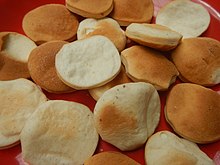 | |
| Type | Biscuit |
|---|---|
| Place of origin | Philippines |
Paborita are Filipino disc-shaped biscuits with a flaky texture. They are made with wheat flour, sugar, skim milk, salt, baking powder, alum, and cooking oil. They are very similar in taste to galletas de patatas. They are traditionally eaten paired with hot drinks or with fruit preserves.[1][2][3][4][5]
Paborita is the famous biscuit of the 68-year old Panaderia Pantoja, making it since 1950. Celinda Laurel Dimayuga (Tanauan) and Aurelio Maningat Pantoja (Balayan) used a "pugon" (clay brick oven). Spouses Arturo Dimayuga Pantoia and Marilyn Gonzales managed the bakery and mechanized it in 1970. Located in Sixto Castillo Street, Barangay Poblacion 2, Tanauan, Batangas, the heritage bakery is famous for traditional Filipino breads and biscuits.[6][7]

See also[edit]
References[edit]
- ^ "Paborita biscuits from Tibiao Bakery". Flavours of Iloilo. Retrieved March 27, 2019.
- ^ "Paborita biscuits". Flavours of Iloilo. Retrieved March 27, 2019.
- ^ "Lorzano's Bakery: More Than a Paborita Story". FoodBatangas. Archived from the original on March 27, 2019. Retrieved March 27, 2019.
- ^ "Philippine Biscuits". Ane Ventures. Retrieved March 27, 2019.
- ^ "This 68-Year Old Bakery in Batangas is Famous For Traditional Filipino Breads and Biscuits". Yummy.ph. Retrieved March 27, 2019.
- ^ Alabastro, Anthony (September 18, 2022). "Taking an old another town panaderia to next leverl". PressReader. Retrieved May 13, 2024.
- ^ Cruz, Chino (May 7, 2018). "This 68-Year Old Bakery In Batangas Is Famous For Traditional Filipino Breads And Biscuits". yummy.ph. Retrieved May 13, 2024.

Well, that’s interesting to know that Psilotum nudum are known as whisk ferns. Psilotum nudum is the commoner species of the two. While the P. flaccidum is a rare species and is found in the tropical islands. Both the species are usually epiphytic in habit and grow upon tree ferns. These species may also be terrestrial and grow in humus or in the crevices of the rocks.
View the detailed Guide of Psilotum nudum: Detailed Study Of Psilotum Nudum (Whisk Fern), Classification, Anatomy, Reproduction